The Quantum Frontier: How Fundamental Discoveries Shape the Global Power Race
Why fundamental science decides winners
“If you think AI is revolutionary—remember, AI is a spin-off of quantum mechanics.”
From navigation to nuclear power, the nations that harness fundamental physics set the pace for economic strength and national security. In a fast, funny, and remarkably accessible talk, Barak Dayan—head of the Quantum Optics group at the Weizmann Institute and co-founder of Quantum Source—walked QWC attendees through three breakthroughs that rewired humanity’s understanding of reality and, with it, global power.
Discovery #1: Maxwell → Einstein → a new map of spacetime
In 1862, James Clerk Maxwell’s unification of electricity and magnetism revealed light as an electromagnetic wave traveling at a constant speed—no medium required. Decades later, Einstein recognized that a constant light speed demands relativity: motion and gravity warp space and time. What once seemed abstract now underpins GPS timing corrections and modern navigation—and produced the era-defining relation E = mc².
Discovery #2: Planck’s constant → quantum mechanics → the digital age of matter
To solve the “blackbody” puzzle, Max Planck quantized energy in discrete packets proportional to frequency (the birth of h). Einstein extended the idea to light itself—photons—and, with Bohr, Schrödinger, and others, ushered in quantum mechanics. Today, everything from atomic clocks to medical imaging to semiconductor scaling down to ~tens of atoms rides on quantum behavior. As Dayan put it: the AI revolution is a spin-off of quantum physics.
Discovery #3: Bell, Aspect & friends → entanglement is real (and useful)
Einstein’s “spooky action” objection met its match when John Bell derived a testable inequality—and experiments in the 1980s (and beyond) violated it. Entanglement is now a resource: it reframes information itself and enables tasks like quantum key distribution. But turning that resource into fault-tolerant computation is the frontier.
The scale problem—and a photonic path forward
Prototype devices with ~100 qubits won’t crack real-world problems; millions of logical qubits will. Dayan argued that to get there we need modularity and “cut-and-paste” assembly—strengths of photonic architectures that can stitch small cluster states across time (via fiber) and space (via many sources). The bottleneck is deterministic resource generation at scale.
From lab insight to industrial engine
Here’s where Dayan’s Weizmann + industry perspective shows: photon–atom gates on a chip can generate deterministic photonic resources rather than one-in-a-million successes. That’s the approach his company, Quantum Source, is taking—aiming to launch a deterministic resource module next year—pushing photonics toward the million-qubit era.
